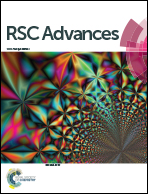A compatibility study on the glycosylation of 4,4′-dihydroxyazobenzene†
Abstract
Photoresponsive glycoconjugates based on the azobenzene photoswitch are valuable molecules which can be used as tools for the investigation of carbohydrate–protein interactions or as precursors of shape-switchable molecular architectures, for example. To access such compounds, glycosylation of 4,4′-dihydroxyazobenzene (DHAB) is a critical step, frequently giving heterogeneous results because DHAB is a challenging glycosyl acceptor. Therefore, DHAB glucosylation was studied using nine different glycosyl donors, and reaction conditions were systematically varied in order to find a reliable procedure, especially towards the preparation of azobenzene bis-glucosides. Particular emphasis was put on glucosyl donors which were differentiated at the primary 6-position (N3, OAc) for further functionalisation. The present study allowed us to identify suitable glycosyl donors and reaction conditions matching with DHAB, affording the bis-glycosylated products in fair yields and good stereocontrol.



 Please wait while we load your content...
Please wait while we load your content...